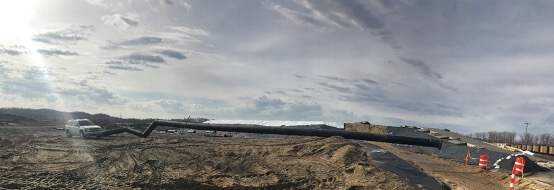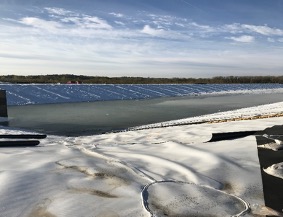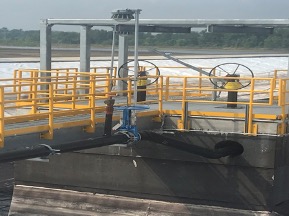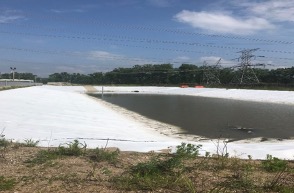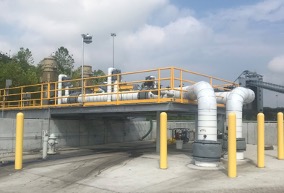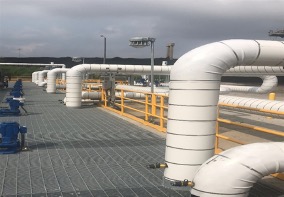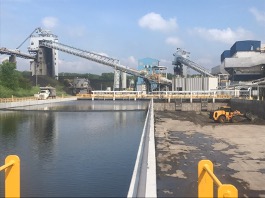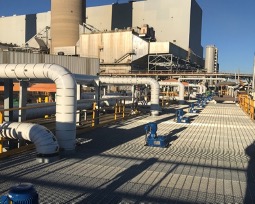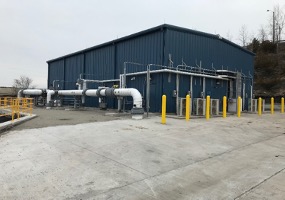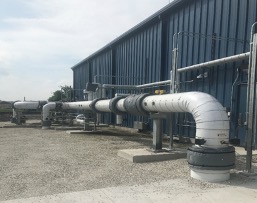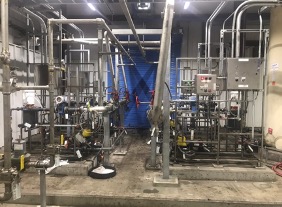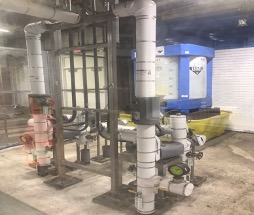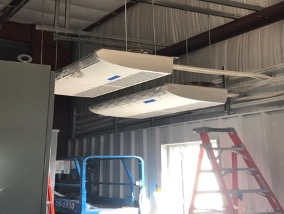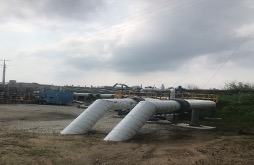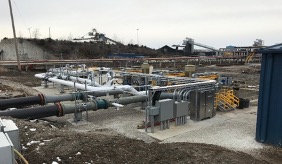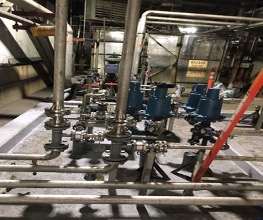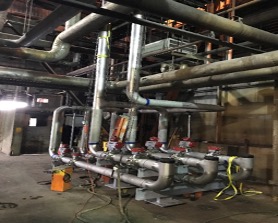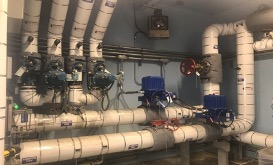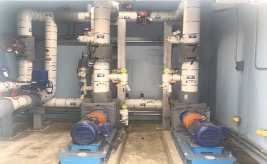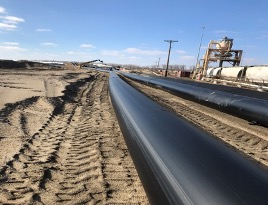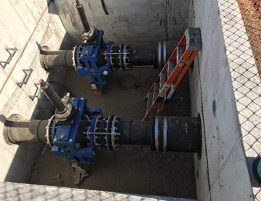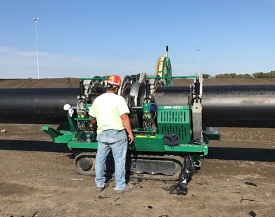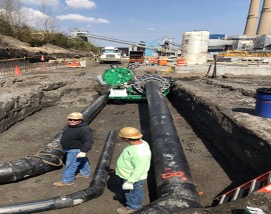Ameren Missouri Labadie Elg Waste Water Project
Project Sketches and Blueprints
Project Scope
As part of this work the bottom ash pond which served as a large wastewater settling basin, had to be closed. Because of closing the bottom ash ponds, Ameren had to develop a new wastewater settling system. Total wastewater flows at the plant site are 35,000 gallons per minute during a 25 year 24 hour rain event. A wastewater system would have been prohibitively expensive at these flowrates. We were able to separate the wastewater on the east side of the plant, since it was just storm water. The storm drains on this side of the plant were rerouted to a new east detention basin that was built as part of the project. This reduced the wastewater flow to the combined drain sump (CDS). As a secondary wastewater storage device, the project also built the west detention basin to handle large storm water flows at the plant that are combined with wastewater and must be treated as wastewater. During large rainstorms, the low volume CDS pumps continue to pump water to the wastewater basin. When the low volume pump capacity is exceeded, the CDS level starts to rise. At a certain level, the CDS high volume pumps start up and pump water to the west detention basin for temporary storage. The wastewater basin handles average plant wastewater flows of 1,500-5,500 gallons per minute during periods when it is not raining. This basin also continues to handle wastewater during rainstorms.
Another aspect of the project was that the demineralizer discharge system had to be redone due to the closing of the ash pond. The demineralizer regeneration system had two discharge pipes: one pipe was for pressurized hazardous waste and the other was for pressurized non-hazardous waste. The non-hazardous waste line has always gone to the CDS. The pressurized hazardous waste line was sent to the bottom ash pond. This fluid flow had the pH neutralized in the bottom ash pond and at the outfall. We had to neutralize this waste stream before we could send it to the new wastewater basin. This was done by routing the pressurized hazardous waste discharges for each demineralizer to new stainless steel storage tanks. Two 80,000 gallon tanks were installed (one backup) to handle a typical demineralizer regeneration of 40,000 gallons. Once the demineralizer regeneration was completed, the waste in the tank was neutralized with either 93% sulfuric acid injection or 50% sodium hydroxide injection diluted to 10%. The design of the acid and caustic pumping systems was a joint design effort between Ameren and Haberberger. After the waste is confirmed neutralized, it is pumped to the low volume wastewater basin. The two tanks allow the simultaneous regeneration of two demineralizers. It is important to not restrict the production of demineralized water for the plant.
To support the low volume waste (LVW) wastewater basins, a new building was built at the south end of the wastewater basins. The building contained an acid and caustic room, a polymer room, control room and electrical equipment room.
The acid and caustic injection system, the polymer system and the HVAC system were a joint design effort between Ameren and Haberberger. The acid and caustic room contained two small acid and two small caustic pumps and acid and caustic totes. These pumps are required when the discharge pH of the wastewater basins is out of specification. The normal allowable discharge range of pH is between 6.5 and 9 pH. If neutralization is needed, one pump is turned on, the acid or caustic is mixed in a mixing pipe with wastewater, a pH probe transmits the pH signal to the digital control system (DCS), and the pump speed is controlled to dose the acid or caustic properly and maintain the proper discharge pH of the wastewater.
The polymer system consists of a 5,000 gallon polymer tank and four polymer skids. Because of the critical nature of keeping the polymer flowing, there are four identical skids. Two skids provide polymer to the CDS area pipe injection and two skids provide polymer injection directly into the wastewater basin. One CDS polymer skid and one wastewater basin polymer skid may be required to be running during different operating scenarios. Typically, just one CDS polymer skid is operating. The polymer skid has a treated water regulation system to control inlet water pressure, a polymer pump and a mixing chamber. The treated water is sent to the mixing chamber, the positive displacement pump, pumps polymer to the mixing chamber, the polymer and water is mixed, and the mixture is sent to either the CDS discharge piping or the wastewater basin. The positive displacement pump has the speed varied to pump different amounts of polymer depending on the wastewater flows, the dirtiness of the wastewater flows and rain events. The wastewater quality is monitored with a turbidity meter to monitor the wastewater quality.
Haberberger was also responsible for designing the HVAC system. The HVAC system was designed to have 100% heating backup, 100% cooling backup and 100% ventilation backup due to the critical nature of the wastewater system for the plant.
Several challenges complicated this project. The main complexities consisted of integrating existing systems to the new systems. The plant demineralizer systems are a crucial system for the plant since they support all four units with clean demineralized boiler water. Large amounts of demineralized water are required for unit startups and when tube leaks occur. The project had to make tie ins to the existing 93% sulfuric and 50% sodium hydroxide piping systems. These tie ins removed the regeneration systems for all three demineralizers from service. We also had to make tie ins to the pressurized hazardous waste systems on three demineralizers. Each tie in required an outage on one demineralizer system. One of the drain lines that we were installing from the west detention basin to the combined drain sump just happened to intersect the pressurized hazardous waste discharge piping. It took six months to get the outage on all the demineralizers to complete this drain line.
The combined drain sump (CDS) work had to be completed in two stages. There were four vertical turbine sump pumps in the CDS. They initially pumped to the bottom ash pond. We had to install the new pumps in shifts. The old pumps had to be removed and the new pumps installed. Since the CDS continually receives wastewater from the plant, we always required a minimum of two pumps running. We split the CDS work in halves. All the structural steel was always designed with keeping two pumps in service in mind. The C and D pumps were removed first, the new steel frame installed and then the pumps and piping installed. Once the new system was started up and the plant was satisfied with the operation of the C and D pumps, the A and B pumps were removed, the frame finished, and the pumps and piping were installed and started up.
Project Outcome
Successful power plant projects are easy to maintain, easy to operate and are simple. Keeping equipment simple in a relatively complex industry is what delivers successful projects. Providing easy access for operating and maintaining equipment takes a tremendous amount of foresight. The project was successful in providing adequate space for maintenance and operations activities despite space constraints in the demineralizer area. The innovation on the project was dividing half the plant into a storm water drainage area that removed storm water from the normal wastewater stream. Adding the west detention basin as a storage area for combination storm water and wastewater was also a simple concept, but it reduced the wastewater facility size. The east detention basin addition and the west detention basin addition reduced a 35,000 gallons per minute facility down to 5,500 gallons per minute wastewater facility. Wastewater settling basins were also chosen over clarifiers for a several million dollar cost reduction with a much simpler system to operate and maintain. These innovations which lower customer costs are what really makes a big impact. Saving significant amounts of money and making the project simpler is what innovation is all about.
Haberberger installed more than 20,000 feet of pipe and “The quality of the 316SS, Alloy 20, carbon steel and HDPE welding were truly outstanding” as described by Ameren. Haberberger made 2,571 welds not including the HDPE welds. Haberberger had third party inspectors along with Ameren weld inspectors reviewing the work. All welds were visually inspected along with additional NDE. Rework was less than 1/4 percent. Flange makeup was also excellent. There were many different size flanges, flange materials, raised and flat face, unusual valves, numerous gasket materials, and different bolting on the job. Quality control tables were provided with flange sizes, gasket thicknesses and materials, bolting materials, thread lubricant and bolt torque requirements. The pressure testing was done in an orderly fashion and was successful in preventing process leaks with hazardous materials once the system was in service.
Testimonials Demonstrating Satisfaction of Owner, Design Professionals, Subcontractors and/or Suppliers.
Gredell Engineering Resources, Inc. (Gredell Engineering) was the design engineer for the West Detention Basin and the HDPE influent and effluent piping to the West Detention Basin. Thomas (Tom) Gredell was the Engineer of Record for the project. Gredell Engineering was also the lead CQA engineer for the construction of the West Detention Basin. Our field staff worked closely with Haberberger field staff on the welding, field fabrication and installation of the piping within the Labadie Bottom Ash Pond. Our field staff found Haberberger’ s staff to be professional, competent, proficient and helpful in installing the HDPE pipe. Tom Gredell periodically attended weekly project construction meetings to address or resolve piping questions, design changes, etc. I always found Pat Reilly and other Haberberger representatives at those meetings to be open, honest and cooperative in resolving piping questions and/or conflicts.
Haberberger Mechanical was a true partner to Ferguson Enterprises at the Ameren Labadie Wastewater Treatment project. Ameren’s high benchmarks of quality protect their workers, the contractors onsite, and ultimately the consumer. Haberberger was acutely aware of these standards, and their attention to detail protected all parties. Haberberger was prompt and detailed in their communication regarding the grade of materials, the test reports required, and the timelines required to make the project profitable. Because of this communication and complete commitment to success, there was a mutual understanding that only the finest service and products would be tolerated. We were honored to partner with an organization like Haberberger, that demanded this respect for a high profile project; this respect set the tone for our business partnerships.
As the general contractor for the Ameren Labadie ELG project, Plocher Construction, would like to express our gratitude to Haberberger on a job well done on the mechanical scope of the project. The project could not have been a success without Haberberger’ s skill, knowledge, work ethic, and attitude toward safety. As a team, we met the project milestones on schedule with no lost time or recordable incidents. When the project was changed to add scope and almost double the manhours on the job, Haberberger was able to crew up and execute the work in a timely manner with the quality of the work being done to the expectations of Plocher and the owner. Once again, we at Plocher would like to thank the Haberberger team for the effort put forth into making this project successful.
Ameren Missouri: I have worked with Haberberger on several Ameren Missouri construction projects during the past ten years. They have always provided thorough, well-documented proposals in response to our requests for bid. They perform high quality mechanical construction work in the field, and they communicate very well with other project stakeholders – Ameren project and energy center personnel, general contractors, other contractors, and vendors. The Labadie wastewater treatment project had many challenges. There were many design changes made during construction, and Haberberger showed great flexibility and cooperation in handling them. They did an excellent job laying out and installing thousands of feet of HDPE piping systems throughout the energy center site, with sizes varying from a few inches to 36 inches. Haberberger also installed a great deal of steel and stainless steel piping systems. Quality of the welding was excellent. The Haberberger personnel on this project were friendly, professional and a pleasure to work with. The wastewater treatment system went into service on time and under budget, and Haberberger was a key contributor to the success of the project.
Project Stats
- Haberberger Contract Amount: $6,484,403
- Construction Schedule: January 2017 – November 2019
- Ameren Missouri Project Manager: Bill Stillman
- Haberberger Project Manager: Pat Reilly
- Haberberger Field Superintendent: Frank Piel
- General Contract: Plocher Construction

